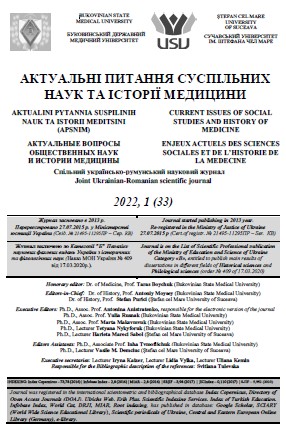СУТНІСТЬ ТА ОСОБЛИВОСТІ СЕРЕДНЬОВІЧНОЇ ІДЕНТИЧНОСТІ
ESSENCE AND FEATURES MEDIEVAL IDENTITY
Author(s): Mykhailo YURIYSubject(s): Christian Theology and Religion, 6th to 12th Centuries, Inter-Ethnic Relations, Politics and Identity, Identity of Collectives
Published by: Видавництво ВДНЗ України « Буковинський державний медичний університет »
Keywords: Medieval identity; anthropology; mentality; ethnicity; Christianity;
Summary/Abstract: The first is an analysis of medieval identity based on an interdisciplinary approach. Secondly, highlighting the peculiarities of the formation of ancient identity. Research methods: empirical (observation, description) and theoretical (analysis, synthesis, abstraction, generalization, induction, deduction, explanation, classification). The scientific method includes methods of research systematization, adjustment of new and previously acquired knowledge. This can be seen in the analysis and systematization of the stages of formation of Slavic identity. The conclusions are made using the rules and principles of reasoning based on empirical data on the influence of Christianity on the formation of identity in the Slavs. Scientific novelty. The process of identity formation in the ancient Slavs was studied for the first time. Active mechanisms of differentiation and integration, definition and self-determination of people, groups and groups are the processes of identification in their broadest sense. The hierarchy of the latter is significantly complicated in historical development along with the growing diversity of structural and substantive and functional phenomena of the social world. This is clearly traced in the process of identifying the Slavs who were part of Kievan Rus, which can be divided into several periods. The first period – VII – VIII centuries. The centers of consolidation of tribes and their self-awareness at this time were cities, especially Kyiv. There were alliances of tribes, among which the Polyany union stood out. At the head of these first pre-state formations were tribal chiefs-princes. The ruling elite began to form. The second period covers three quarters of the ninth century. At this stage, the foundations of statehood were formed. It was Kyiv that initiated the political unification of the lands into a state. A social hierarchy began to form. At the top of the pyramid – the prince and his wife, then – ordinary corporations of the tribal nobility, and at the bottom – the peasant and urban communities. Identification processes are intensifying at all levels of this hierarchy. The third period is associated with the emergence of a single ancient n state – Kievan Rus. In 882 the Varangian king Oleg captured Kyiv. The Kyiv state spread rapidly and was powerful. The population of Ancient Russia was strongly influenced by multi-vector and ethnic factors, where the identification process took place. With the adoption of Christianity, the attitude of chroniclers to Russia changed dramatically. Both they and the readers of their works could not help but realize that from that moment it fell into a new context of ethnic and political relations. After baptism, the main opposition to the Christian movement became “bad” peoples, that is, the main principle of identification “We – They” began to operate. Conclusions. It is proved that only with the adoption of Christianity we can talk about full-fledged identification processes in Kievan Rus: the Old Slavonic language, both ecclesiastical and literary, came into use, as the language of public administration and legislation; unified traditions, customs, legal norms have taken root; there was a single material culture, there was, albeit not fully, a single ethnic identity; consolidated the elite of the feudal lords of ancient Russia, which traced its lineage from the Rurik dynasty and did not divide itself ethnically.
Journal: Актуальні питання суспільних наук та історії медицини
- Issue Year: 2022
- Issue No: 1
- Page Range: 22-26
- Page Count: 5
- Language: Ukrainian

